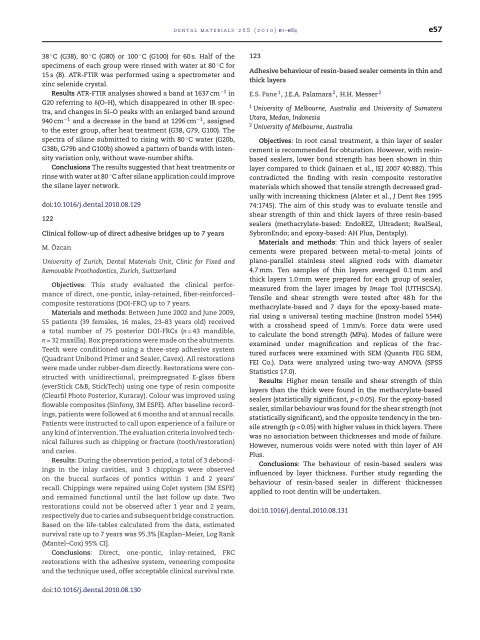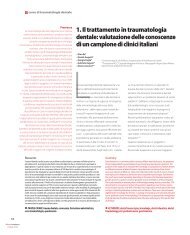Abstracts of the Academy of Dental Materials Annual ... - IsiRed
Abstracts of the Academy of Dental Materials Annual ... - IsiRed
Abstracts of the Academy of Dental Materials Annual ... - IsiRed
You also want an ePaper? Increase the reach of your titles
YUMPU automatically turns print PDFs into web optimized ePapers that Google loves.
38 ◦ C (G38), 80 ◦ C (G80) or 100 ◦ C (G100) for 60 s. Half <strong>of</strong> <strong>the</strong><br />
specimens <strong>of</strong> each group were rinsed with water at 80 ◦ C for<br />
15 s (B). ATR-FTIR was performed using a spectrometer and<br />
zinc selenide crystal.<br />
Results ATR-FTIR analyses showed a band at 1637 cm −1 in<br />
G20 referring to �(O–H), which disappeared in o<strong>the</strong>r IR spectra,<br />
and changes in Si–O peaks with an enlarged band around<br />
940 cm −1 and a decrease in <strong>the</strong> band at 1296 cm −1 , assigned<br />
to <strong>the</strong> ester group, after heat treatment (G38, G79, G100). The<br />
spectra <strong>of</strong> silane submitted to rising with 80 ◦ C water (G20b,<br />
G38b, G79b and G100b) showed a pattern <strong>of</strong> bands with intensity<br />
variation only, without wave-number shifts.<br />
Conclusions The results suggested that heat treatments or<br />
rinse with water at 80 ◦ C after silane application could improve<br />
<strong>the</strong> silane layer network.<br />
doi:10.1016/j.dental.2010.08.129<br />
122<br />
Clinical follow-up <strong>of</strong> direct adhesive bridges up to 7 years<br />
M. Özcan<br />
University <strong>of</strong> Zurich, <strong>Dental</strong> <strong>Materials</strong> Unit, Clinic for Fixed and<br />
Removable Prosthodontics, Zurich, Switzerland<br />
Objectives: This study evaluated <strong>the</strong> clinical performance<br />
<strong>of</strong> direct, one-pontic, inlay-retained, fiber-reinforcedcomposite<br />
restorations (DOI-FRC) up to 7 years.<br />
<strong>Materials</strong> and methods: Between June 2002 and June 2009,<br />
55 patients (39 females, 16 males, 23–83 years old) received<br />
a total number <strong>of</strong> 75 posterior DOI-FRCs (n = 43 mandible,<br />
n = 32 maxilla). Box preparations were made on <strong>the</strong> abutments.<br />
Teeth were conditioned using a three-step adhesive system<br />
(Quadrant Unibond Primer and Sealer, Cavex). All restorations<br />
were made under rubber-dam directly. Restorations were constructed<br />
with unidirectional, preimpregnated E-glass fibers<br />
(everStick C&B, StickTech) using one type <strong>of</strong> resin composite<br />
(Clearfil Photo Posterior, Kuraray). Colour was improved using<br />
flowable composites (Sinfony, 3M ESPE). After baseline recordings,<br />
patients were followed at 6 months and at annual recalls.<br />
Patients were instructed to call upon experience <strong>of</strong> a failure or<br />
any kind <strong>of</strong> intervention. The evaluation criteria involved technical<br />
failures such as chipping or fracture (tooth/restoration)<br />
and caries.<br />
Results: During <strong>the</strong> observation period, a total <strong>of</strong> 3 debondings<br />
in <strong>the</strong> inlay cavities, and 3 chippings were observed<br />
on <strong>the</strong> buccal surfaces <strong>of</strong> pontics within 1 and 2 years’<br />
recall. Chippings were repaired using CoJet system (3M ESPE)<br />
and remained functional until <strong>the</strong> last follow up date. Two<br />
restorations could not be observed after 1 year and 2 years,<br />
respectively due to caries and subsequent bridge construction.<br />
Based on <strong>the</strong> life-tables calculated from <strong>the</strong> data, estimated<br />
survival rate up to 7 years was 95.3% [Kaplan–Meier, Log Rank<br />
(Mantel–Cox) 95% CI].<br />
Conclusions: Direct, one-pontic, inlay-retained, FRC<br />
restorations with <strong>the</strong> adhesive system, veneering composite<br />
and <strong>the</strong> technique used, <strong>of</strong>fer acceptable clinical survival rate.<br />
doi:10.1016/j.dental.2010.08.130<br />
dental materials 26S (2010) e1–e84 e57<br />
123<br />
Adhesive behaviour <strong>of</strong> resin-based sealer cements in thin and<br />
thick layers<br />
E.S. Pane 1 , J.E.A. Palamara 2 , H.H. Messer 2<br />
1 University <strong>of</strong> Melbourne, Australia and University <strong>of</strong> Sumatera<br />
Utara, Medan, Indonesia<br />
2 University <strong>of</strong> Melbourne, Australia<br />
Objectives: In root canal treatment, a thin layer <strong>of</strong> sealer<br />
cement is recommended for obturation. However, with resinbased<br />
sealers, lower bond strength has been shown in thin<br />
layer compared to thick (Jainaen et al., IEJ 2007 40:882). This<br />
contradicted <strong>the</strong> finding with resin composite restorative<br />
materials which showed that tensile strength decreased gradually<br />
with increasing thickness (Alster et al., J Dent Res 1995<br />
74:1745). The aim <strong>of</strong> this study was to evaluate tensile and<br />
shear strength <strong>of</strong> thin and thick layers <strong>of</strong> three resin-based<br />
sealers (methacrylate-based: EndoREZ, Ultradent; RealSeal,<br />
SybronEndo; and epoxy-based: AH Plus, Dentsply).<br />
<strong>Materials</strong> and methods: Thin and thick layers <strong>of</strong> sealer<br />
cements were prepared between metal-to-metal joints <strong>of</strong><br />
plano-parallel stainless steel aligned rods with diameter<br />
4.7 mm. Ten samples <strong>of</strong> thin layers averaged 0.1 mm and<br />
thick layers 1.0 mm were prepared for each group <strong>of</strong> sealer,<br />
measured from <strong>the</strong> layer images by Image Tool (UTHSCSA).<br />
Tensile and shear strength were tested after 48 h for <strong>the</strong><br />
methacrylate-based and 7 days for <strong>the</strong> epoxy-based material<br />
using a universal testing machine (Instron model 5544)<br />
with a crosshead speed <strong>of</strong> 1 mm/s. Force data were used<br />
to calculate <strong>the</strong> bond strength (MPa). Modes <strong>of</strong> failure were<br />
examined under magnification and replicas <strong>of</strong> <strong>the</strong> fractured<br />
surfaces were examined with SEM (Quanta FEG SEM,<br />
FEI Co.). Data were analyzed using two-way ANOVA (SPSS<br />
Statistics 17.0).<br />
Results: Higher mean tensile and shear strength <strong>of</strong> thin<br />
layers than <strong>the</strong> thick were found in <strong>the</strong> methacrylate-based<br />
sealers (statistically significant, p < 0.05). For <strong>the</strong> epoxy-based<br />
sealer, similar behaviour was found for <strong>the</strong> shear strength (not<br />
statistically significant), and <strong>the</strong> opposite tendency in <strong>the</strong> tensile<br />
strength (p < 0.05) with higher values in thick layers. There<br />
was no association between thicknesses and mode <strong>of</strong> failure.<br />
However, numerous voids were noted with thin layer <strong>of</strong> AH<br />
Plus.<br />
Conclusions: The behaviour <strong>of</strong> resin-based sealers was<br />
influenced by layer thickness. Fur<strong>the</strong>r study regarding <strong>the</strong><br />
behaviour <strong>of</strong> resin-based sealer in different thicknesses<br />
applied to root dentin will be undertaken.<br />
doi:10.1016/j.dental.2010.08.131



